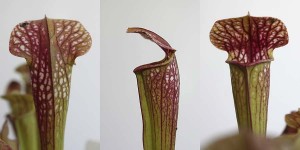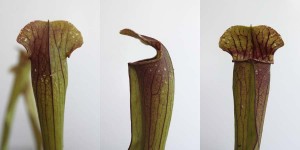
Last year a visitor to the garden was asking about the little bags that were on some of the flowers. It looked like it was time to explain the birds and the bees to the curious visitor.
That was Year One of my making some hybrids using Sarracenia, one of the two North American carnivorous pitcher plant genera. Most of the plants live outdoors and get visited by various insects. The little bags were condoms against larger insects getting to the flower and delivering pollen from a different flower than I’d intended to be used in a hybrid. In the South, where most of these plants originate, the flowers are pollinated by a large bee that isn’t found here in Southern California. But I looked at the layer of protection as insurance against some other insect getting to the flower and doing its own experiments with plant breeding. I wanted these flowers all to myself.
When I was shopping at the fabric store I was a little distressed to find that the mesh fabric I was interested in was labeled “petticoat liner.” I thought I was a fairly open-minded and liberated male, but I felt a little shy going up to the counter with a bolt of the stuff, sort of like the first time you go up to the pharmacy counter with a box of condoms.

The clerk sensed my discomfort and supportively asked what I was going to do with the fabric. I explained. “Interesting idea,” she said. “I use big pieces of it to cover up my fruit trees to keep the birds out.” Oh good. A fellow gardener. This person understands. I left the store feeling much less stressed.
These bags aren’t the most virtuosic sewing projects you’ll encounter, just a long rectangle of fabric that’s been hand sewn up the sides to make a long tube. I use paperclips to hold the sheaths in place, but with a little more effort you can sew in some ribbon or string to make something resembling gift pouches that you can open and close easily.

It’s good to make at least a couple different sizes to accommodate the different bloom sizes found in this genus. This season I ran out of larger bags and ended using an actual gift bag left over from the holidays. Its white-gold color stands out pretty emphatically in the garden. If you were starting from scratch, a darker color would recede into the garden more gracefully.
These bags don’t provide protection against smaller pollinators. After doing a little more research it appears that the gold standard for material for hybridizing bags seems to be reemay, the breathable spun polyester that’s used for floating row covers in the garden. Scientific papers frequently cite Reemay bags being used in controlled pollination situations. That stuff is bright white and really stands out in the garden. Fortunately these bags only need to be on Sarracenia flowers for two to three weeks, so you won’t be defacing your garden permanently. Still, while your plants are wearing them, you might have to do a little more explaining to people visiting your plant collection…










